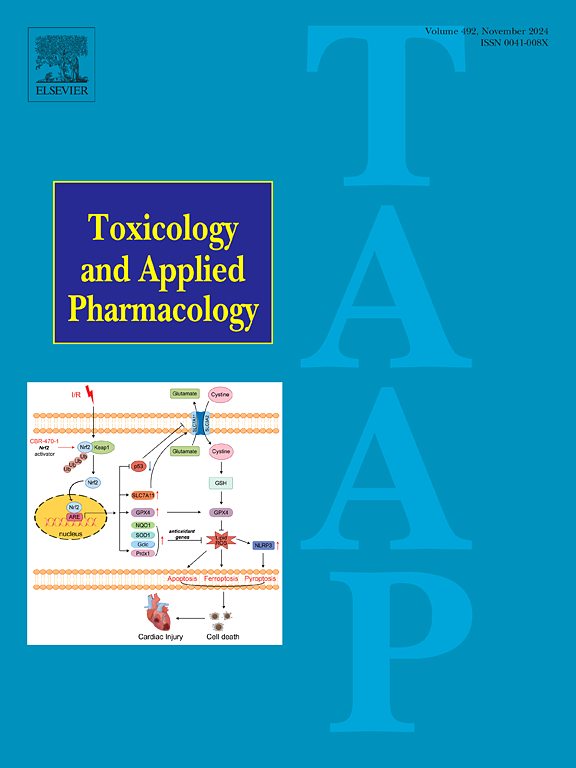二甲双胍通过增强雌性小鼠线粒体生物合成和表观遗传修饰来减轻镉诱导的生殖毒性
IF 3.4
3区 医学
Q2 PHARMACOLOGY & PHARMACY
引用次数: 0
摘要
镉是一种普遍存在的环境污染物,对各种组织和细胞产生有害影响,特别是针对生殖系统,从而对动物食品安全和人类健康构成重大风险。尽管镉的影响广泛,但对能够减轻镉引起的生殖毒性的物质的研究仍然很少,特别是在女性生殖健康方面。二甲双胍是一种广泛使用的口服降糖药物,已经证明了一系列的有益作用,包括抗衰老和抗氧化特性。本研究旨在探讨二甲双胍减轻镉诱导的雌性生殖毒性的潜力和潜在机制。在连续35天的时间里,小鼠暴露于镉污染的水(32 mg/l)中,并口服溶解在0.2 ml生理盐水中的10 mg二甲双胍。我们的研究结果表明,二甲双胍有效地减轻镉诱导的发情周期、卵泡发育和卵母细胞减数分裂成熟的中断。具体来说,二甲双胍通过增加线粒体质量和生物合成来促进卵母细胞ATP的产生,从而抵消镉诱导的氧化应激和减数分裂过程中的纺锤体形态缺陷。此外,二甲双胍恢复卵母细胞的DNA修复能力,减轻镉诱导的DNA损伤。这种恢复作用部分是由二甲双胍改善关键表观遗传修饰的能力介导的,如卵母细胞中的组蛋白乙酰化、组蛋白甲基化和DNA甲基化。这些结果强调了二甲双胍作为镉生殖毒性的保护或治疗药物的潜力,主要是通过维持细胞稳态来增强卵母细胞对镉毒性的恢复能力,并保持正常的表观遗传修饰来确保卵母细胞的质量。本文章由计算机程序翻译,如有差异,请以英文原文为准。
Metformin alleviates cadmium-induced reproductive toxicity by enhancing mitochondrial biosynthesis and epigenetic modifications in female mice
Cadmium, a pervasive environmental pollutant, exerts detrimental effects on various tissues and cells, particularly targeting the reproductive system, thereby posing significant risks to both animal food safety and human health. Despite its widespread impact, research on substances capable of mitigating cadmium-induced reproductive toxicity remains scarce, especially concerning female reproductive health. Metformin, a widely used oral antihyperglycemic drug, has demonstrated a range of beneficial effects, including anti-aging and antioxidant properties. This study aims to investigate the potential and underlying mechanisms of metformin in alleviating cadmium-induced reproductive toxicity in females. Over a period of 35 consecutive days, mice were exposed to cadmium-contaminated water (32 mg/l) and orally administered 10 mg metformin dissolved in 0.2 ml normal saline. Our findings reveal that metformin effectively mitigates cadmium-induced disruptions in the estrous cycle, follicular development, and oocyte meiotic maturation. Specifically, metformin enhances ATP production in oocytes by boosting mitochondrial mass and biosynthesis, thereby counteracting cadmium-induced oxidative stress and spindle morphology defects during meiosis. Additionally, metformin restores the DNA repair capacity of oocytes, alleviating cadmium-induced DNA damage. This restorative effect is partially mediated by metformin's ability to improve key epigenetic modifications, such as histone acetylation, histone methylation, and DNA methylation in oocytes. These results underscore metformin's potential as a protective or therapeutic agent against cadmium reproductive toxicity, primarily by maintaining cellular homeostasis to bolster oocyte resilience against cadmium toxicity and preserving normal epigenetic modifications to ensure oocyte quality.
求助全文
通过发布文献求助,成功后即可免费获取论文全文。
去求助
来源期刊
CiteScore
6.80
自引率
2.60%
发文量
309
审稿时长
32 days
期刊介绍:
Toxicology and Applied Pharmacology publishes original scientific research of relevance to animals or humans pertaining to the action of chemicals, drugs, or chemically-defined natural products.
Regular articles address mechanistic approaches to physiological, pharmacologic, biochemical, cellular, or molecular understanding of toxicologic/pathologic lesions and to methods used to describe these responses. Safety Science articles address outstanding state-of-the-art preclinical and human translational characterization of drug and chemical safety employing cutting-edge science. Highly significant Regulatory Safety Science articles will also be considered in this category. Papers concerned with alternatives to the use of experimental animals are encouraged.
Short articles report on high impact studies of broad interest to readers of TAAP that would benefit from rapid publication. These articles should contain no more than a combined total of four figures and tables. Authors should include in their cover letter the justification for consideration of their manuscript as a short article.

 求助内容:
求助内容: 应助结果提醒方式:
应助结果提醒方式:


